- A comprehensive article on how Yoga became popular in the U.S. and people responsible for it.
Dating back to the Indus Valley Civilization around 3000 BCE, Yoga has deep roots in Indic Faiths. Read Brief History of
Yoga Meditation is a yoga technique that provides a sense of calm, balance,
and peace in life. Read Hinduism Today
article All
about Meditation
In the West, Yoga and Meditation both are
used as a form of exercise where it is more posture-based physical fitness,
relaxation technique, and stress relief.
In fact, in India, Yoga is one of six
major schools of philosophy
(Darsana) with its own epistemology,
metaphysics, and ontology.
According to a recent
study by Disturb Me Not, around 36 million Americans practice Yoga.
The number of US yogis increased by over 50% in the past four years and every
year Americans spend $16 billion on yoga classes, equipment, clothing, and
accessories.
Moreover, over 55 million people would practice
Yoga by 2020, with women accounting for 72% of yoga practitioners.
Furthermore, 14 million over the age of fifty
do Yoga, with 44% of yoga practitioners performing Yoga 2-3 times a week. In
fact, around 89% of US yogis practice Yoga 1-5 hours a day on average. (seems
high)
In light of this information, let us take
a quick look at how Yoga and Meditation reached the US and why it has become so
popular in the US.
19th
Century Indian Roots
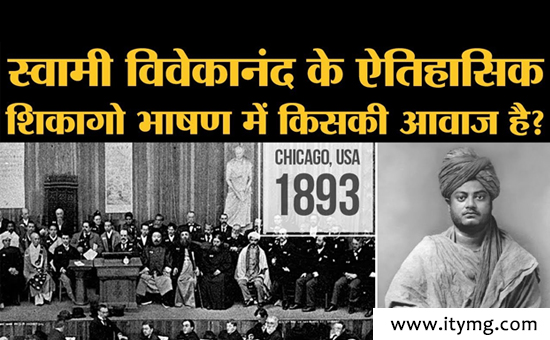
Pic 2 Image Credits
Do know that philosophers Ralph Waldo
Emerson and his student Henry
David Thoreau and had foreshadowed Yoga through their work. Having said that, it is important to know that Emerson was deeply influenced by Indian philosophy. In fact, Robert C Gordon has written a book titled 'Emersen and India'. To read book Bibliography.
To know more about Indian influence on Emersen read article
by Robert Gordon. Robert G has written a book Emersen and the Light of India published by the National Book Trust
of India. It is available here Excerpts from write up, "Emerson and the Light of India thoroughly investigates the ways in which the scriptures of India shaped the maturing Transcendentalism of this great American thinker. In addition, by analyzing in concrete detail the crucial ways in which the scriptures of India influenced Emerson's metaphysical development.” Also read Thoreau’s India-An Outsiders View by V Meenakumari to know influence of Indian Thought on him.
Emersen was not invited to speak at Harvard for thirty years when he challenged
mainstream Christianity in a 1838 speech. Source
However, the actual introduction of Yoga
in the United States happened when Swami Vivekanda visited Chicago on the 31st May 1893, and he carried the title “the bliss of discerning wisdom.” There he became a part of more than 200 adjunct gatherings organized under the Parliament of Religions banner.
When it was his time to make a brief speech, he started with the words "Sisters
and Brothers of America", and for that alone, he received a two-minute standing ovation from a crowd of seven thousand attendees.
During his time, Swami Vivekananda laid
the foundation of yoga breath-work (Pranayama) along with mediation. Read Swami Vivekananda's Contribution to the Discourse of Yoga
However, it is interesting to note that
the early introduction of Yoga was not focused on asanas or the Hatha practice. In fact, they became popular much
later. Asanas are the official name of body posture and the general term for a
meditative sitting pose.
The Hatha Yoga is a later extended form. “The hatha yoga can further be divided into two
categories as has been distinguished by Dattatreya Yoga Shastra. The first
form, practised by Yajnavalkya involves the eight
limbs of yoga while the second form practised by Kapila involves eight mudras.” Source
Yogendraji , Indra
Devi, and Hollywood
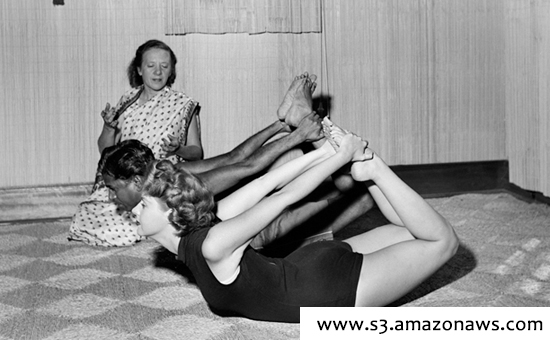
Pic 3 - Image
Credits
While the spiritual and religious aspect
of Yoga were lost to time, the practice of Yoga mainly as a physical endeavor
started in 1919. This was when Manibhai Haribhai Desai, aka Shri
Yogendra (Founder Yoga Institute Mumbai) took Yoga to the U.S. in 1921. He was an extremely important figure behind Hatha Yoga's revival in India. “Back
in India, Shri Yogendraji engaged himself in devising modern methods to impart
yoga, initiating research in yoga, particularly in the field of the yoga therapy.” Source
From there onwards, the stage was set for
Indra Devi to make her grand appearance. From 1948, she brought Yoga much of
its public attention going as far as teaching celebrity and film stars during
the time as her pupils in her studio located in Hollywood. While spiritual
styles also flourished during this time, however, Americans had their eyes set
for a more cosmopolitan and globally popular yoga.
Maharishi Mahesh Yogi – Second Yoga Boom
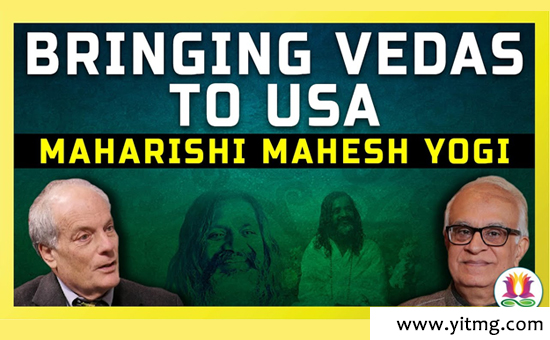
Pic 4 - Image Credits
Maharishi Mahesh Yogi is accredited with
the second boom of spiritual Yoga in the 1960s. This time it was Transcendental Meditation that spread across the United States like wildfire. As an Indian guru, he is best known as the worldwide organization leader, and his title translates to "Great Seer". His cheerful side also became known as the "giggling guru" although his devotees strictly revered him as "His Holiness".
During his time, he is said to have
trained more than 40,000 Transcendental Meditation teachers. They then
transferred this endearing knowledge to more than 5 million people along with founding
thousands of teaching centres and hundreds of colleges, schools, and universities.
He is also a noticeable figure because he
was guru to the world-famous The Beatles music band, The Beach Boys rock band,
and various other celebrities.
The Obvious Health
Benefits
While Yoga was picking pace with the
passage of time in the US, there was an undeniable factor that propelled it
further. These were hard to neglect and evident. It also brought discipline to
the practitioners. Some of the most prominent health benefits include:
- Augemented athletic performance.
- Better energy, respiration, and vitality
- Ease
arthritis symptoms
- Fostering
heart health
- Healthier
metabolism
- Improving
the balance, flexibility, and strength of the musculoskeletal system
- Weight reduction.
Americans Need Yoga
While Yoga promotes healthier lifestyles,
you have to give the Americans the following - stressful lifestyles and just
plain unhealthy fixations. In fact, numerous people in the West get into Yoga
predominantly for physical fitness and stress relief benefits.
To be honest, this is also one of the
primary reasons why Yoga is taken more as a physical excursion rather than
raising your spirituality levels and Meditation.
Plus, we all know for a fact it is more
than just exercise or physical poses alone. It incorporated a rich history
deeply rooted in philosophy and ethical principles apart from breathing
exercises and Meditation.
Note that the Yoga centres that make money
by teaching Yoga do not pay any royalty to the Indian government or any Yoga
organization for using the knowledge of Yoga.
Americans Need
Meditation
Meditation is the training of the mind and
spirit to think more positively. The majority of Americans are getting
attracted to it due to the spiritual connection it creates.
According to Los Angeles Times, around 35
million Americans have tried Meditation. The main reason being the stress and
chaos created by the modern lifestyle.
The living pattern adopted by Americans is
creating significant mental stress. The continuous pressure to perform well and
cope with rapidly changing technology is making life demanding.
Therefore, Americans require making a spiritual
connection with their soul. It not only promotes mental peace and regulates
health, but reduces anxiety and lengthens attention span.
Doing Meditation
Meditation is given a significant place in
Indian thought. The word Meditation is equal to sports in America. There are
different Meditation practices for varied purposes. Meditation for the beginners
is performed in the following manner;
- Choose
a quiet place or room to sit.
- Do not use any stuffing, and sit on the
floor.
- Straighten your back and cross your legs.
- Now focus on one thing it can be; the sound of any equipment, clock's noise, candle, or counting beads.
- Break the process into 10 minutes slot.
- Repeat the process after at least four
times, and increase the period gradually.
Those interested in meditation can read
these two books. A
Million Thoughts: Learn all about meditation by Om Swami and The
Himalayan Tradition of Yoga Meditation by Swami Veda Bharati - Editor.
Schools Encouraging Yoga
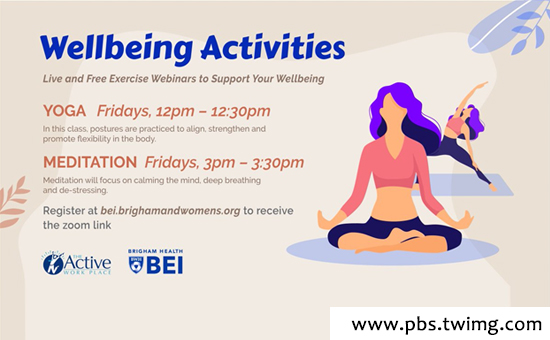
Pic 5 - Image Credits
Many schools across the US also teach
basic yoga techniques to young kids, and then you also have community health
groups as well as organizations that promote Yoga for older folks.
In 2019, The Union Minister said that a
proposal was sent to the MHRD (Morris Hills Regional High School District) that
envisioned Yoga as a compulsory subject under the PE (Physical Education)
curriculum.
Yoga as a Business

Pic 6 Image
Credits
Yoga is considered a BIG business in the
US. The average yoga studio owner makes $7,227 in gross monthly income, roughly
$86,000 per year. That is well above the threshold of average annual earnings
in the US. In terms of revenues, a yoga studio produces over $13,495 per month.
Back in 2015, the yoga industry in the
United States was already amounting to $9.09 billion.
Furthermore, the projected forecast shows
the number of people doing Yoga in the US to grow from 18 million in 2008 to
around 55 million by 2020. Students who buy dissertation
online and practice Yoga are well aware that yoga-related items are
indeed in demand.
Yoga in Pop-Culture
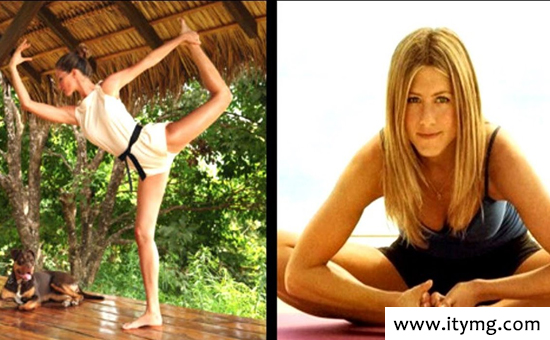
Pic 7 - Image Credits
Yoga has become so common and mainstay in the US that people can instantly realize it from far. Just type in 'yoga pants', and you will end up with over 472 million results on Google. However, Yoga is much more than a form of exercise, and for many, it still holds a sacred value that should never be tarnished with the possessions or status of this materialistic world.
For Americans, Yoga has become a universal
accessory that allows them to interact with each other while abstaining from
any religious entanglements or traditional drawbacks. People find Yoga as a way
to socialize and build long-lasting friendships.
Yoga has been accepted by people, including
celebrities, like if it was a part of their own entity, and over the
years, we have seen Yoga making an appearance everywhere, including the big
screen, TV, billboards, music videos, video games, and much more.
From Oddities to
the Outrageous
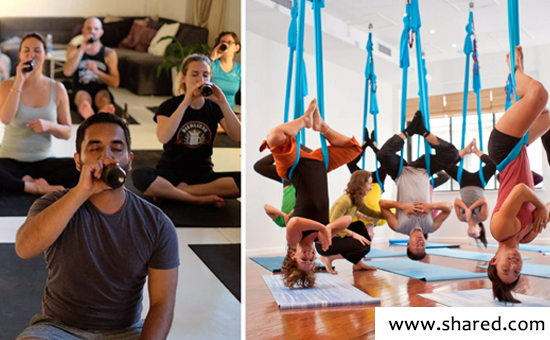
Pic 8 - Image
Credits
As a growing body of knowledge, people
have literarily taken Yoga to unimaginable heights. This is where all the weirdness
and oddities reveal themselves. In fact, there is pretty much a yoga
type for everyone out there. Here are some types of Yoga that I discovered and
are truly outrageous:
Aerial or Aero Yoga, where people defy
gravity and explore a totally new sensation while practicing Yoga and hanging
mid-air with the help of a belt or a hammock.
Beer Yoga is a complete success in Germany
(aka motherland of beer). It has also become quite popular in Australia. It was
created in America around 2013, where people drink beer during or after asana
practice.
Ganja Yoga is popular in California, where
marijuana is legalized. Practitioners state that the conscious use of cannabis
can enhance your performance in many ways.
Nude Yoga or Naked Yoga is the practice of
Yoga without clothes.
Yoga Raves where you wouldn't find any crazy or experimental drugs and neither excessive amounts of alcohol. Yoga raves are simply Yoga, followed by a rave and ending with a meditation session.
Conclusion
Americans view Yoga as a way to reconnect with themselves, their surroundings and finding tranquility, albeit with their busy lives and hectic daily schedules. No matter how you look at it, Yoga is here to stay. In the US, yogis are growing at an incredible pace, and this means yoga businesses are finding new ways to attract customers and flourish.
Plus, in a lot of
communities and neighborhoods, people have come together to set up their own
studio and gyms where they can practice Yoga in all the peace and quiet they
can get for themselves.
Author
Samantha Kaylee currently works
as a Blogger at Crowd Writer and Student Essay. During
her free time, she likes to practice mindful Yoga and meditate.